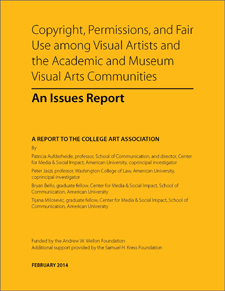 A new report by PIJIP Professor Peter Jaszi, AU Communications Professor Patricia Aufderheide, and AU fellows Bryan Bello and Tijana Milosevic.
A new report by PIJIP Professor Peter Jaszi, AU Communications Professor Patricia Aufderheide, and AU fellows Bryan Bello and Tijana Milosevic.
The College Art Association has commenced a project with American University Professors Jaszi and Aufderheide to develop a Codes of Best Practice in the Creation and Curation of Artworks and Scholarly Publishing inthe Visual Arts. The first phase of the project was to conduct “interviews with one hundred visual arts professionals and a survey of CAA members” and produce a report on “current practices and attitudes among visual arts practitioners (including artists, scholars, editors, and curators) regarding copyright and fair use.” The full report is available here.
KEY FINDINGS
- 1. Visual artists and other visual arts professionals, a term used in this report to include (among others) art historians, educators, professors, editors or publishers, museum professionals,and gallerists, share a common problem in creating and circulating their work: confusion and misunderstanding of the nature of copyright law and the availability of fair use — the limited right to reuse copyrighted material without permission or payment.
- Fair use is flexible, available, and even core to the missions of many visual arts activities.
- Members of the visual arts communities typically overestimate the risk of employing fair use, which leads them to avoid it, even in circumstances where the law permits and so doing would not harm personal relationships necessary for their work.
- They pay a high price for copyright confusion and misunderstanding. Their work is constrained and censored, most powerfully by themselves, because of that confusion and the resulting fear and anxiety.
- The highest cost is scholarship left undone, knowledge not preserved for the next generation, creative use of digital opportunities truncated — the “missing future.”
- Although all members of the visual arts communities of practice share these problems, artists are more likely to use copyrighted material without licensing it, and less likely to abandon or avoid projects because of copyright frustrations.
- There is widespread and often urgent interest with in the visual arts communities of practice in finding ways to address a prevalent “permissions culture.”




